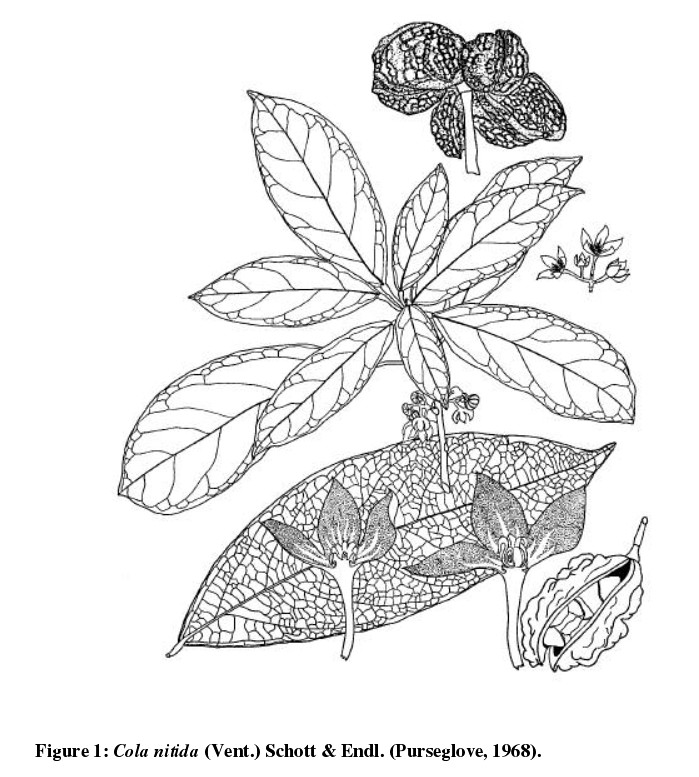Dies ist eine alte Version des Dokuments!
Cola nitida (Vent.) Schott & Endl. - Sterculiaceae - Gbanja cola, bitter cola, Gbanja Kola, Kolabaum
Tree, native to the west coast of Africa (Guinea to Togo), cultivated in Africa, introduced elsewhere (tropics, subtritropics).
„The main flowering flush commences in the middle of the wet season between July and August, but sometimes May-January and gives rise to the crop which is harvested four or five months later. Analysis of 108 herbarium specimens of C. nitida showed that flowers had been collected through most of the year across this species’ range. Few flowering specimens were collected in March-April…
In C. nitida there are two cotyledons and the seeds readily split into half whilst in C. acuminata, where there are three or four cotyledons, sometimes as many as six, the seed splits into a corresponding number of
pieces..
In southern parts of West Africa, the most commonly consumed species is C. acuminata and C. nitida is preferred in northern parts. For example, C. acuminata is the preferred species in western Cameroon and its trade is limited to this region. C. nitida, however, is produced though generally not consumed in this region; what is collected is traded to the North.“
http://carpe.umd.edu/Documents/2001/report-tachieobeng_brown2001.pdf
„Varieties of kola nuts (Cola nitida alba, Cola nitida rubra A. Chev, and Cola acuminata Schott & Endl), a group of popular Nigerian and West African stimulants, were analyzed for their content of secondary plant metabolites. The three varieties of the kola nuts contained appreciable levels of (+)-catechin (27–37 g/kg), caffeine (18–24 g/kg), (−)-epicatechin (20–21 g/kg), procyanidin B1 [epicatechin-(4β→8)-catechin] (15–19 g/kg), and procyanidin B2 [epicatechin-(4β→8)-epicatechin] (7–10 g/kg). Antioxidant capacity of the extracts and purified metabolites was assessed by two HPLC-based and two colorimetric in vitro assays. Extracts of all varieties exhibited antioxidant capacity with IC50 values in the range 1.70–2.83 and 2.74–4.08 mg/mL in the hypoxanthine/xanthine oxidase and 2-deoxyguanosine HPLC-based assays, respectively. Utilization of HPLC-based assays designed to reflect in situ generation of free radicals (e.g., HO•), as opposed to general assays (DPPH, FRAP) in common use which do not, indicate that, of the major secondary plant metabolites present in kola nut extracts, caffeine is potentially the more effective cancer chemopreventive metabolite in terms of its antioxidant capacity.“
[Content of polyphenolic compounds in the Nigerian stimulants Cola nitida ssp. alba, Cola nitida ssp. rubra A. Chev, and Cola acuminata Schott & Endl and their antioxidant capacity. Atawodi, S. E. O., Pfundstein, B., Haubner, R., Spiegelhalder, B., Bartsch, H., Owen, R. W., Journal of agricultural and food chemistry, Vol.55(24), 2007, 9824-9828]
„Catechin, epicatechin, theobromine and caffeine were detected in Cola seeds. Among the three species, C. nitida is found to be highest in flavonoid and caffeine content while C. anomala possessed high amount of theobromine. Catechin was the dominant flavonoid. Caffeine was the major alkaloid in Cola seeds and was considered as one of the signature compounds due to its concentration range. The average concentrations in C. acuminata, C. nitida and C. anomala accessions were 11066 ± 3166, 13761 ± 2728 and 7013 ± 2369 mg/kg FW respectively.“
[Purine alkaloids and phenolic compounds in three Cola species and Garcinia kola grown in Cameroon. Niemenak, N., Onomo, P. E., Lieberei, R., Ndoumou, D. O., South African Journal of Botany, Vol.74(4), 2008, 629-638]
„The mature fruit of Cola species is a nut known as kolanut. It has a bitter flavour and high caffeine content. It is chewed in many West African cultures individually or in a group setting. It is often used ceremonially, presented to tribal chiefs or to guests. Chewing kolanut can ease hunger pangs. Kolanuts are used mainly for their stimulant and euphoriant qualities… It is chewed in many West African cultures individually or in a group setting. It is often used ceremonially, presented to tribal chiefs or to guests.“
[Phytochemical and Antimicrobial Studies of Four Species of Cola Schott & Endl. (Sterculiaceae), Mubo Adeola Sonibare, Micheal O Soladoye, Oyedokun O Esan, Oluwadayo O Sonibare, Afr J Tradit Complement Altern Med., Vol.6(4), 2009, 518–525] http://www.ncbi.nlm.nih.gov/pmc/articles/PMC2816472/pdf/AJT0604-0518.pdf
„C. nitida extract inhibited α-amylase (EC50=0.34 mg/mL) and α-glucosidase (EC50=0.32 mg/mL) activities as well as Fe2+ induced lipid peroxidation in rat pancreas in a dose dependent manner. In addition, the extract had high DPPH radical scavenging ability (EC50=2.2 mg/mL) and reducing power (8.2 mg AAE/g). Characterization of the main phenolic compounds of the extract using gas chromatography analysis revealed catechin (6.6 mg/100 g), epicatechin (3.6 mg/100 g), apigenin (5.1 mg/100 g) and naringenin (3.6 mg/100 g) were the main compounds in the extract. This antioxidant and enzyme inhibition could be some of the possible mechanism by which C. nitida is use in folklore for the management/treatment of type-2 diabetes. However, the enzyme inhibitory properties of the extract could be attributed to the presence of catechin, epicatechin, apigenin and naringenin.“
[Inhibitory effect of polyphenolic-rich extract from Cola nitida (Kolanut) seed on key enzyme linked to type 2 diabetes and Fe2+ induced lipid peroxidation in rat pancreas in vitro. Oboh, G., Nwokocha, K. E., Akinyemi, A. J., Ademiluyi, A. O., Asian Pacific journal of tropical biomedicine, 4(Suppl 1), 2014, 405]
http://www.ncbi.nlm.nih.gov/pmc/articles/PMC4025302/

http://carpe.umd.edu/Documents/2001/report-tachieobeng_brown2001.pdf
